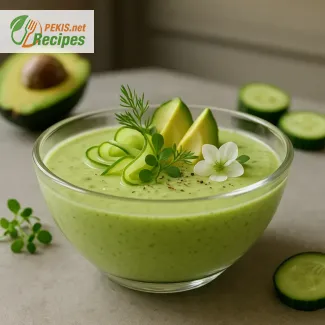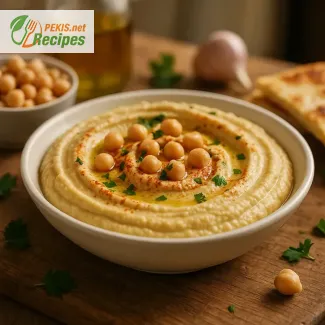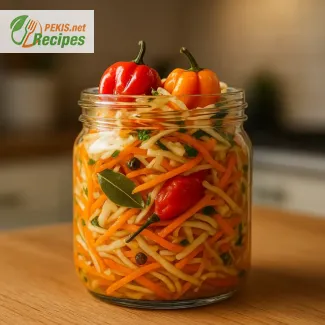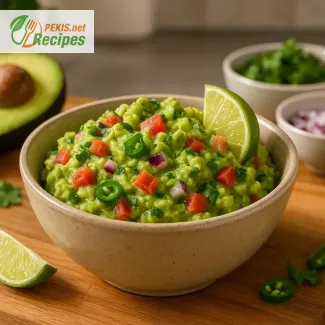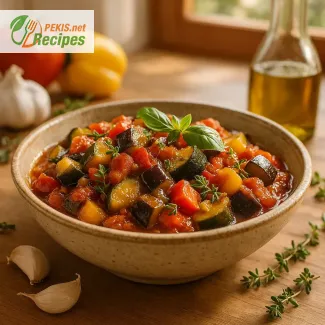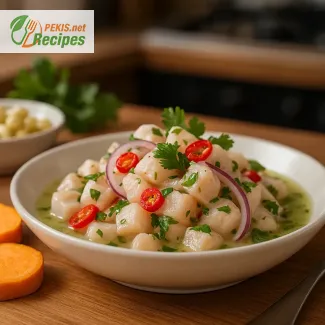
Discover the Bold Flavors of Peru with This Vibrant Ceviche
A refreshing fusion of citrus, spice, and the ocean’s essence
When it comes to fresh seafood dishes that celebrate simplicity and purity of ingredients, ceviche stands out as a crown jewel of Peruvian cuisine. Revered for its bright citrus notes, clean texture, and lively flavor, this traditional dish has transcended borders to become a global favorite among gourmet enthusiasts and home cooks alike.
Made by marinating raw fish in lime juice, ceviche relies on the natural acidity of citrus to gently cure the seafood, creating a texture that’s tender yet firm, without a single moment over the stove. This chemical reaction – known as denaturation – is what transforms ceviche from raw fish into a delicacy with a firm bite and zesty flavor.
Ceviche is more than just a dish; it's an expression of the coastal regions of Peru, where the Pacific Ocean meets local markets filled with chilies, onions, and coriander. Every bite carries the sharpness of fresh lime, the sweetness of thinly sliced red onions, and the unexpected heat of ají limo or chili pepper, delivering a symphony of flavors that’s as invigorating as it is delicious.
The cultural roots of authentic Peruvian ceviche
While ceviche recipes vary by region, the classic Peruvian version is regarded as the most traditional. In Peru, ceviche is typically served with sweet potatoes, boiled corn, or crunchy cancha (toasted corn kernels) — not just as garnishes, but as essential companions that balance out the acidity and spice. This harmony of textures and flavors reflects the culinary philosophy of Peru, where ingredients are celebrated in their purest forms.
One defining element of authentic ceviche is the use of firm white fish, such as sea bass, snapper, or cod, chosen for their ability to hold shape and absorb flavor without becoming mushy. Another hallmark is the inclusion of leche de tigre, the milky marinade left behind after marinating the fish, often sipped as an energizing tonic or served alongside the dish for dipping.
Ceviche is traditionally consumed immediately after preparation, emphasizing freshness and preserving the brightness of its ingredients. The dish has become a culinary icon, even earning recognition as part of Peru’s national heritage and celebrated each year on National Ceviche Day.
Ingredients that define the experience
At the heart of every great ceviche is lime juice — not lemon, which is too sweet and lacks the bracing acidity needed for curing fish. The lime must be freshly squeezed, never bottled, to ensure maximum impact on flavor and texture. Combine this with thinly sliced onions, fresh chilies, and a touch of sea salt, and you have a marinade that not only preserves but also amplifies the natural flavor of the fish.
Coriander, also known as cilantro, adds a bright herbal lift, while optional ingredients like garlic, ginger, or even passion fruit juice are sometimes introduced in modern variations to add complexity. However, the true spirit of Peruvian ceviche lies in its restraint — allowing a handful of vibrant ingredients to shine in perfect balance.
Why ceviche is ideal for summer meals and gatherings
Ceviche is often associated with warm-weather dining, beachside tables, and lively gatherings. Its refreshing profile and cool presentation make it a perfect dish for summer, whether served in small appetizer portions or as a light, protein-rich main course.
It’s naturally gluten-free, low in fat, and requires no cooking, making it a favorite among health-conscious eaters and busy hosts alike. It can be prepared in advance (within reason), plated beautifully in individual bowls or on large platters, and even served in shot glasses or on tostadas for modern flair.
Beyond its visual appeal and nutritional benefits, ceviche invites creativity. Home cooks can explore variations using shrimp, scallops, or even mango and avocado. But at its core, the most beloved version always returns to white fish marinated in lime, a testament to the elegance of simplicity.
Selecting the right fish and tools for preparation
The success of any ceviche recipe begins with choosing the freshest fish available. Look for fillets that are firm to the touch, translucent, and free of any strong odor. Wild-caught options are often preferred, especially those from cold-water sources known for their pristine quality.
Use a non-reactive bowl, such as glass or ceramic, to marinate the fish — metal bowls can interfere with the acidity of the lime juice and alter the flavor. A sharp knife is essential for thin, even slices of fish and onion, ensuring the dish not only tastes great but also looks refined.
To extract the most juice from your limes, roll them firmly on the countertop before slicing. This breaks down the membranes and yields more liquid. Juice the limes only when you’re ready to marinate the fish — oxidation begins immediately, and freshly squeezed juice makes all the difference.
Modern twists and regional influences
While traditional Peruvian ceviche remains a timeless favorite, chefs around the world have embraced the dish with their own interpretations. From Japanese-Peruvian Nikkei ceviche featuring soy sauce and sesame oil, to tropical renditions with pineapple and coconut milk, ceviche continues to evolve without losing its soul.
Even within Peru, regional differences abound. In the north, ceviche may be more generously seasoned and spicy, while in Lima it tends to be light and refined. The Amazonian version might include river fish and exotic herbs rarely found outside the rainforest.
Despite its adaptability, what unites all variations is the reverence for fresh, raw fish and citrus-based curing — a culinary method as old as time and as modern as today’s finest restaurants.
- Rinse the fresh white fish under cold water and pat it dry with paper towels. Cut it into uniform cubes about 1.5 cm (½ inch) thick to ensure even curing.
- Place the fish in a non-reactive glass or ceramic bowl. Add a few ice cubes to keep the temperature low while you prepare the other ingredients.
- Add the finely sliced red onion, minced garlic, and chopped chili to the fish. Gently toss to combine.
- Pour the freshly squeezed lime juice over the mixture. Stir well so that the citrus covers all the fish pieces evenly. Let it marinate for 10–12 minutes. The fish will turn opaque and firm, indicating it is cured.
- Remove the ice cubes if used. Stir in the chopped coriander, sea salt, and cracked black pepper. Mix gently to avoid breaking the fish.
- Taste and adjust salt or chili to your preference.
- Plate the ceviche with slices of boiled sweet potato and a side of cooked corn or cancha. Optionally, drizzle some of the leche de tigre (the citrusy marinade) over the top. Serve immediately.
Elevate Your Ceviche Experience with Simple Enhancements
Smart ingredient swaps, preparation tips, and flavor-boosting secrets
Creating the perfect ceviche isn’t just about following a recipe — it’s about understanding the delicate balance of acidity, texture, and freshness. While the traditional Peruvian version delivers a bright and refreshing dish, there are countless ways to refine and personalize the experience without compromising authenticity. Whether you're preparing it for the first time or looking to improve your go-to version, these expert suggestions will help you bring out the best in your ceviche.
Choose superior fish for better texture and flavor
The foundation of any ceviche is the fish. Traditional recipes call for firm white fish like sea bass, snapper, or grouper. But upgrading to ultra-fresh sushi-grade halibut or wild-caught cod can result in a cleaner, more delicate taste and a better mouthfeel. Opting for sustainably sourced varieties not only improves the ethical profile of your dish but also often guarantees better quality.
When slicing the fish, ensure uniform cubes no thicker than 1.5 cm (½ inch). Smaller pieces cure more evenly and absorb the lime marinade more efficiently, avoiding rubbery textures.
Adjust acidity for a smoother citrus profile
Peruvian ceviche is defined by its zesty lime juice, which “cooks” the fish through a chemical process. However, using only lime can sometimes make the flavor overly sharp or bitter. A well-balanced alternative is to blend lime juice with a splash of orange or grapefruit juice, adding subtle sweetness and rounding out the acidity. This adjustment is particularly helpful when serving ceviche to those sensitive to strong citrus flavors.
Avoid bottled lime juice at all costs — freshly squeezed juice is essential to the brightness and integrity of the dish.
Add umami and depth without overpowering
To give ceviche a more complex umami note, consider adding a small amount of fish sauce, tamari, or even a few drops of soy sauce. These ingredients should be used sparingly and added after curing the fish, to avoid affecting the marinade’s acidity.
Another depth-enhancing addition is finely grated ginger or a small amount of passion fruit pulp, which adds a tropical twist and complements the heat of fresh chilies.
Upgrade the chili component for more nuanced heat
The traditional ají limo chili is often difficult to find outside of Peru. While red chili peppers or jalapeños are commonly used as substitutes, elevating the dish with thinly sliced habaneros or fermented chili paste can introduce more complexity. If serving to guests with varying spice tolerance, offer sliced chilies on the side or prepare two levels of heat.
Use seasonal garnishes and local produce
While sweet potato and corn are classic accompaniments, swapping in mango slices, avocado wedges, or even grilled pineapple can add dimension and a refreshing counterpoint to the acidity. Garnishing with microgreens, radish slices, or shaved fennel enhances both visual appeal and crunch.
For an elegant touch, serve your ceviche in chilled martini glasses with citrus zest sprinkled over the top — a presentation that’s both modern and practical.
Avoid these common ceviche mistakes
Even the freshest ingredients can result in a subpar ceviche if missteps are made. One major error is over-marinating the fish. Leaving the fish in lime juice for longer than 15–20 minutes can result in a tough, chalky texture. Always monitor the curing time and serve immediately once the fish has turned opaque.
Another common mistake is cutting the fish too unevenly, leading to inconsistent texture and taste. Similarly, avoid overpowering the dish with garlic or chili — both should enhance, not dominate.
Do not skip proper chilling. Keeping the fish cold before and during marination is essential for food safety and freshness.
Healthier alternatives for a lighter dish
Ceviche is already a low-fat, protein-rich dish, but further improvements can make it even healthier. For a lighter version, substitute fish with shrimp, scallops, or even thinly sliced zucchini or mushrooms for a vegetarian twist. These alternatives still absorb the citrus marinade beautifully and can surprise even purist ceviche fans.
Swapping regular salt for pink Himalayan salt or sea salt flakes adds minerals while reducing sodium content slightly. You can also increase the fiber and vitamin content by serving the ceviche on a bed of spiralized vegetables instead of corn or potatoes.
Why homemade ceviche always wins
Preparing ceviche at home ensures control over ingredient quality, marination time, and customization. Unlike pre-made versions or restaurant dishes, you can avoid preservatives, excess sodium, or hidden sugars. You also tailor the heat level, acidity, and garnishes to your taste — a level of personalization that elevates the dining experience.
Moreover, crafting your own ceviche allows you to honor its cultural roots while making it uniquely yours. With just a few mindful adjustments and attention to detail, this vibrant dish transforms into a gourmet centerpiece that’s as nourishing as it is flavorful.
Allergens present in the recipe:
- Fish
Gluten:
- Gluten-free by default
Suggestions to eliminate allergens:
- For individuals allergic to fish, substitute with hearts of palm, mushrooms, or firm tofu cured in the same marinade. While this deviates from traditional ceviche, it preserves the texture and acidity without triggering fish allergies.
Vitamins and minerals per serving (approximate):
- Vitamin C: 35 mg – Supports immune function and skin health
- Vitamin B12: 1.8 µg – Essential for red blood cell production and nervous system
- Folate: 55 µg – Important for cell division and prenatal development
- Potassium: 540 mg – Regulates blood pressure and fluid balance
- Magnesium: 34 mg – Supports muscle function and energy production
- Iron: 1.2 mg – Contributes to oxygen transport in blood
- Phosphorus: 210 mg – Essential for bone structure and cellular repair
- Zinc: 1.1 mg – Aids in metabolism and immune response
Antioxidants per serving (approximate):
- Quercetin (from red onion): 8 mg – Reduces inflammation and supports cardiovascular health
- Beta-carotene (from sweet potato): 3.5 mg – Converted to Vitamin A, promotes eye and skin health
- Lutein + Zeaxanthin (from corn): 2.2 mg – Support eye function and protect against macular degeneration
- Vitamin E (from fish and coriander): 1.1 mg – Protects cells from oxidative stress
